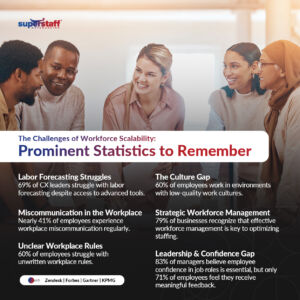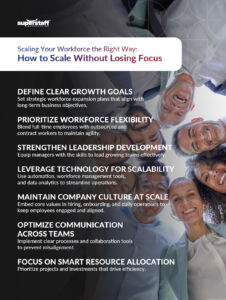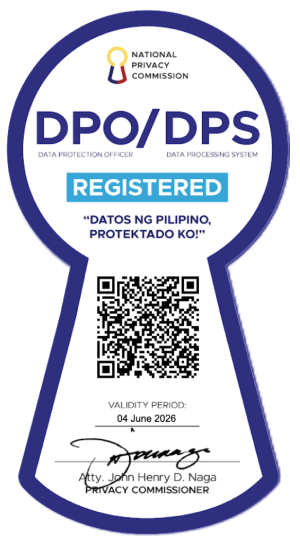
Growth is exciting—until it starts pulling your business in too many directions.
One moment, you’re scaling up to meet demand. The next, you’re drowning in inefficiencies, struggling to keep teams aligned, and watching quality slip through the cracks. This is the workforce scalability dilemma: the challenge of expanding without losing focus.
In a market where opportunities move fast, businesses that can’t scale efficiently risk missing out—or worse, collapsing under their own weight. Expanding your workforce shouldn’t mean sacrificing what made your company successful in the first place.
This blog breaks down the strategies to scale your business with intention, keeping your operations sharp, your team engaged, and your mission intact. If growth is on your horizon, now is the time to scale your business right.
Understanding Workforce Scalability

Workforce scaling is about ensuring sustainable growth that aligns with your business goals. Companies that scale effectively can adapt to shifting demands without compromising service quality or operational efficiency. However, achieving this balance is easier said than done.
One of the biggest challenges in workforce scaling is predicting staffing needs accurately. According to Zendesk, 69% of CX leaders struggle with labor forecasting despite having access to advanced management tools. This reflects a common issue: businesses often expand reactively, adding staff when workloads become overwhelming rather than proactively planning for future growth. Without a clear strategy, companies risk inefficiencies, overworked employees, and service bottlenecks that impact customer satisfaction.
To scale a business effectively, your organization must track key metrics such as employee productivity, time-to-hire, and retention rates. These indicators help decision-makers assess whether their expansion efforts are supporting your business goals or straining resources. Additionally, flexible staffing models—such as outsourcing customer service or back-office operations—can provide the agility needed to scale up or down without the long-term commitment of hiring full-time employees.
Technology also plays a vital role. Leveraging workforce management platforms and data analytics can improve forecasting, optimize staffing levels, and enhance overall efficiency. As Zendesk’s findings suggest, learning how to scale a business isn’t just about growing—it’s about growing smart and ensuring the right people are in place at the right time.
But scaling a workforce isn’t without its challenges. Without careful planning, rapid expansion can introduce inefficiencies that derail a company’s momentum. Let’s explore some of the hidden pitfalls that come with unchecked growth.
Hidden Challenges of Rapid Expansion As You Scale Your Business
Scaling a business brings exciting opportunities, but unchecked growth can introduce operational challenges that quickly spiral out of control. Many companies underestimate how expansion affects communication, efficiency, and overall company cohesion. Without careful planning, businesses may find themselves growing in size but losing their ability to function effectively.
One of the biggest obstacles is administrative complexity. As a company scales, HR processes, compliance requirements, and day-to-day operations become increasingly difficult to manage. Hiring surges can overwhelm internal teams, leading to slow onboarding, payroll errors, and inconsistent policy enforcement. If processes don’t scale alongside growth, businesses risk unnecessary delays, compliance failures, and rising operational costs.
Miscommunication also becomes a major issue. Small teams operate with agility, but as a company grows, the flow of information can easily break down. Forbes found that nearly 41% of employees regularly encounter workplace miscommunication, with breakdowns happening on a daily or weekly basis. As businesses expand, these lapses in communication can cause teams to work in silos, slow decision-making, and create confusion over responsibilities.
On top of that, another Forbes study revealed that 60% of employees struggle with unclear or unwritten workplace rules, making it harder for new hires and existing staff to stay aligned. When rapid expansion forces organizations to shift priorities quickly, these communication gaps can deepen, leaving employees disengaged and uncertain about company expectations.
Perhaps the most concerning challenge of fast-paced growth is the decline in quality control. Rushing to hire and train employees can result in inconsistencies, leading to poor customer service and operational errors. When new hires aren’t adequately prepared, their performance suffers, affecting both internal processes and customer satisfaction. Companies that fail to maintain quality control during scaling often experience growing pains that damage their reputation and long-term success.
To scale a business successfully, leaders must anticipate these challenges and build safeguards to keep their teams aligned and efficient. One of the most effective ways to do this is by fostering a strong company culture—one that remains intact even as the workforce expands. Let’s explore how organizations can preserve their culture while scaling.
Preserving Company Culture During Expansion
Scaling a business is more than just adding new people—it’s about ensuring that the company’s culture and values grow alongside the workforce. Without a strong cultural foundation, rapid expansion can lead to inconsistencies, disengaged employees, and operational inefficiencies. Yet, building and maintaining a quality-driven culture remains a challenge for many businesses.
According to Gartner, 60% of employees work in environments where company culture lacks a strong foundation for quality. This means that as companies grow, many employees struggle with unclear expectations, misalignment in values, and a disconnect from the organization’s mission. On the other hand, Gartner further expands on this insight by stating that businesses that successfully establish a culture of quality see 46% smaller mistakes and 75% reduced customer-facing product errors, proving that investing in culture isn’t just about employee satisfaction—it directly impacts operational efficiency and customer experience.
To maintain cultural consistency during expansion, your business must be intentional about hiring and onboarding. Ensuring that new hires align with your company’s values—not just job descriptions—helps sustain the workplace identity and keeps teams working toward a common goal. Additionally, your organization should prioritize cultural continuity across different locations, whether through shared company traditions, structured mentorship programs, or digital engagement tools that foster connection.
When companies commit to building a strong, quality-driven culture, they set themselves up for long-term success. Once culture is solidified, the next challenge is ensuring that business operations remain scalable and efficient—an area where technology plays a crucial role.
Leveraging Technology for Effective Management
Scaling a workforce without the right technology is like trying to build a skyscraper without a blueprint. It’s chaotic, inefficient, and bound to cause problems. As teams grow, so do administrative demands, coordination challenges, and performance-tracking needs. Without modern tools to support expansion, businesses risk falling behind due to mismanaged workloads and slower response times.
Technology plays a critical role in ensuring workforce scalability remains efficient and sustainable. HR and project management software simplify hiring, onboarding, and daily operations, allowing businesses to scale without overwhelming internal teams. Data analytics provide real-time performance insights, helping leaders make informed decisions about staffing, resource allocation, and productivity improvements. For businesses managing hybrid or remote teams, communication platforms ensure that employees stay connected, fostering collaboration across multiple locations.
According to Zendesk, 79% of businesses acknowledge that strategic workforce management is essential for optimizing staffing and reducing customer wait times. This means that most businesses recognize the value of technology in managing growth—but not all have successfully implemented the right systems. Those who do, however, gain a competitive edge by automating routine tasks, ensuring their teams remain agile, and proactively addressing potential bottlenecks.
When leveraged correctly, technology doesn’t just support growth—it accelerates it. But tools alone aren’t enough. The next step in managing scalability effectively is adopting flexible staffing solutions that allow businesses to remain agile as they expand.
Flexible Staffing Solutions: A Smarter Way to Scale

Expanding your business requires the right mix of talent, agility, and cost-efficiency. Relying solely on full-time hires can be expensive and rigid, especially when demand fluctuates. That’s where flexible staffing solutions come in, offering a strategic way to scale while maintaining operational control.
One of the biggest advantages of flexible staffing is outsourcing specialized functions. Whether it’s customer support, back-office operations, IT services, or content moderation, outsourcing allows you to tap into skilled professionals without the overhead costs of hiring and training in-house employees. This is especially valuable if your company is entering new markets, launching seasonal campaigns, or handling temporary surges in workload.
Beyond outsourcing, contract, freelance, and temporary hires provide companies with additional adaptability. Your business can scale your workforce up or down as needed without the long-term financial commitment of permanent positions. This agility is particularly beneficial for industries with seasonal peaks, such as e-commerce, travel, and retail, where demand can spike dramatically during certain times of the year.
However, success with flexible staffing requires careful planning and integration. You must ensure that outsourced and temporary employees are aligned with company goals, trained effectively, and supported with the right tools. When implemented strategically, blending full-time employees with a flexible workforce allows you to stay competitive, respond quickly to market shifts, and manage expansion without unnecessary risk.
With a flexible workforce in place, the next challenge is making sure leadership and management are equipped to guide teams effectively during rapid growth. Let’s explore how strong leadership plays a critical role in workforce scalability.
Developing Leadership and Management Capabilities
Effective leadership is the cornerstone of successful business expansion. As companies scale, strong leaders ensure that teams remain focused, motivated, and aligned with the organization’s mission. Without capable management, rapid growth can lead to disorganization, decreased morale, and a dilution of company culture.
Investing in leadership development is not just beneficial—it’s essential. According to KPMG, 83% of managers, both first and middle-level, express that it’s crucial for their team members to be confident in their job responsibilities. This confidence often stems from effective leadership that provides clear guidance, support, and opportunities for professional growth. However, the same survey reveals that only 71% of employees feel they receive constructive feedback during meetings with their managers, indicating a gap that needs addressing.
To bridge this gap, companies should consider implementing comprehensive leadership training programs. These programs can equip managers with the skills needed to communicate effectively, provide meaningful feedback, and foster an environment where employees feel valued and understood. Additionally, promoting a culture of continuous learning encourages leaders to adapt to new challenges and evolving business landscapes.
Mentorship opportunities also play a vital role in leadership development. By pairing emerging leaders with experienced mentors, organizations can facilitate knowledge transfer, build confidence, and ensure that company values are upheld across all levels of management.
As businesses expand, the complexities of managing larger teams and operations increase. Strong leadership acts as a guiding force, ensuring that growth is sustainable and aligned with the company’s core objectives. With capable leaders at the helm, organizations are better positioned to navigate the challenges of expansion while maintaining operational excellence.
With leadership and management capabilities strengthened, the next focus is on enhancing operational efficiency to support growth without losing focus. Let’s delve into strategies that can streamline processes and sustain quality during expansion.
Enhancing Operational Efficiency
Scaling your business without prioritizing operational efficiency is like trying to build a tall and elaborate building on shaky ground—things might stand for a while, but cracks will eventually start to show.
Growth doesn’t just mean doing more; it means doing more with precision. The companies that scale successfully are the ones that streamline their operations as they expand, making efficiency a non-negotiable priority rather than an afterthought.
One of the smartest ways to enhance efficiency is process optimization and automation. By fine-tuning workflows and automating repetitive tasks, your business can cut down on overhead, reduce human error, and free up employees to focus on high-value work. Whether it’s using AI-powered chatbots to handle routine customer inquiries or implementing cloud-based project management systems to keep teams aligned, automation helps businesses scale without stretching internal resources too thin.
Another key factor? Effective delegation and workflow management. As teams grow, you must resist the urge to micromanage everything—not only is it inefficient, but it can also slow down progress and frustrate employees. Instead, your business should focus on ensuring tasks are handled by the right people at the right time. Clear role definitions, accountability structures, and streamlined approval processes help prevent bottlenecks that could stall momentum.
But operational efficiency alone isn’t enough. The real magic happens when efficiency is balanced with innovation—because while fine-tuning operations is crucial, businesses that fail to evolve eventually get left behind. Let’s explore how to strike the right balance between innovation and execution.
Balancing Innovation with Focused Execution
Innovation is the engine that drives long-term success. But if a company pursues every new idea without focus, it risks losing sight of what truly matters. The key to sustainable growth is strategic innovation, where new initiatives are carefully aligned with business goals and executed with precision.
One of the biggest mistakes companies make is chasing shiny object syndrome—jumping on every new trend, technology, or product idea without a clear connection to their core mission. This kind of scattered approach can drain resources, create internal confusion, and dilute brand identity.
Instead, your organization should focus on prioritizing projects that align with its long-term vision. Every innovation should have a clear purpose: Does it improve efficiency? Enhance customer experience? Drive revenue growth? If the answer is no, it’s probably a distraction.
That doesn’t mean you should play it safe, either. Encouraging calculated risk-taking is critical for staying competitive. Businesses that are too risk-averse can become stagnant, while those that take measured, data-driven risks often discover breakthroughs that fuel future growth. The key is balance—giving teams the freedom to innovate while ensuring there’s a structured process for vetting and testing new ideas.
Setting clear, measurable goals for innovation is another essential step. Without defined success metrics, even the best ideas can lose momentum before they make an impact. Companies should outline key performance indicators (KPIs) for every new initiative, track progress, and be willing to pivot or scrap projects that aren’t delivering results.
The companies that master this balance—embracing innovation without losing focus—are the ones that scale successfully. They stay ahead of competitors, build resilient business models, and create lasting value in the market.
Empower Scalability in Your Workforce With SuperStaff
Scaling your business is about growing strategically while keeping your operations sharp, your culture strong, and your focus intact. Without the right approach, rapid expansion can lead to inefficiencies, disengaged teams, and diluted priorities. But with a clear strategy and the right partners, you can scale without losing what makes them successful in the first place.
The key to sustainable workforce scalability lies in smart growth strategies—understanding the challenges of expansion, preserving company culture, leveraging technology, adopting flexible staffing solutions, strengthening leadership, and balancing innovation with execution. Businesses that master these elements don’t just grow—they thrive.
The real question is: Are you scaling the right way? If you’re ready to expand your workforce without the usual pitfalls, SuperStaff can help. As an experienced outsourcing provider, we specialize in helping businesses scale efficiently, cost-effectively, and with strategic precision. From customer support and back-office services to specialized roles, we provide the flexibility, expertise, and operational support needed to grow without unnecessary risks.
Let’s build a workforce that scales with your business—without sacrificing quality or focus. Partner with SuperStaff today and take the next step toward smarter, more sustainable growth!






